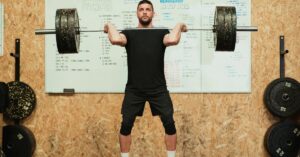Hey there, fitness enthusiasts! If you’ve ever wondered whether squats fall into the ‘push’ or ‘pull’ category of exercises, you’re in the right place.
Today, we’re diving into the intriguing world of squats and settling the debate once and for all. So, grab a seat (or a squat rack) and let’s get started on this fitness journey!
Push or a pull: Defining Squat Place in Your Workout Routine.
A squat is neither a push nor a pull exercise; it is a lower-body compound movement. Squats primarily target the muscles in your legs, including the quadriceps, hamstrings, and glutes, as well as the muscles in your lower back and core for stability.
This exercise involves bending your knees and hips while keeping your torso upright and then returning to a standing position.
Squats are a fundamental movement in strength training and are often included in leg workouts to build lower body strength and endurance.
They are not categorized as push or pull exercises, which typically refer to upper body movements like push-ups (push) and pull-ups (pull).

Further Explanations.
Let’s dive deeper and elaborate further on all the points mentioned.
let’s delve deeper into the mechanics and categorization of squats as a lower-body compound movement.
1. Muscles Targeted:
Leg Muscles:
Squats predominantly target the muscles in your lower body. The quadriceps, which are the muscles on the front of your thighs, are heavily engaged during the upward phase of the squat, as they are responsible for extending your knees.
Hamstrings and Glutes:
As you squat down, your hamstrings (muscles at the back of your thighs) and glutes (buttocks) are actively engaged to control the descent and provide power for the ascent.
Lower Back:
Squats require a stable lower back, which means the muscles of the lower back are activated to maintain proper posture throughout the movement.
Core:
Your core muscles play a crucial role in stabilizing your spine during squats. They help keep your torso upright and prevent excessive forward or backward leaning.
2. Compound Movement:
Squats are considered a compound movement because they involve multiple joints and muscle groups working together.
In this case, the hip and knee joints are both involved, and various muscle groups collaborate to perform the exercise effectively.
3. Functional Strength:
Squats are a functional exercise, meaning they mimic movements we perform in our daily lives, such as sitting down and standing up.
This functional aspect makes squats an essential exercise for building overall strength and mobility.
4. Push vs. Pull:
To clarify further, the terms “push” and “pull” generally refer to the direction of force application in exercises.
Push exercises involve exerting force away from your body, such as in push-ups, where you push your body away from the ground.
Pull exercises involve exerting force towards your body, like in pull-ups, where you pull your body up towards a bar.
Squats, on the other hand, don’t involve pushing or pulling in the traditional sense. Instead, they focus on vertical movement—up and down.
In all this is that, squats are a versatile lower-body exercise that engages various muscle groups and joints.
They are excellent for building lower body strength, improving functional fitness, and enhancing core stability.
While they aren’t categorized as push or pull exercises, they are a fundamental part of strength training and are essential for developing a strong and balanced physique.
A complete tabular on this topic here.
Here’s a complete tabular breakdown of whether a squat is categorized as a push or pull exercise:
| Aspect | Squat Classification |
|---|---|
| Primary Movement | Lower-Body Compound |
| Targeted Muscles | Quadriceps, Hamstrings, Glutes, Lower Back, Core |
| Compound Movement | Yes |
| Functional Strength | Yes |
| Push or Pull | Neither |
| Description | Squats involve bending your knees and hips while keeping your torso upright and then returning to a standing position. This movement primarily targets the lower body muscles, including the quadriceps, hamstrings, and glutes, as well as engaging the lower back and core for stability. While squats are a compound movement and build functional strength, they are not categorized as push or pull exercises. Push and pull exercises typically refer to upper body movements, such as push-ups (push) and pull-ups (pull). |
In summary, squats are neither a push nor a pull exercise. They are a lower-body compound movement that targets various muscles and are essential for building lower body strength and overall functional fitness.
My Conclusion.
A squat is neither a push nor a pull exercise; it is a lower-body compound movement primarily targeting the muscles in the legs, lower back, and core.
It is not categorized as a push or pull exercise, which typically refer to upper body movements.

Hey there, it’s Mike Rrsq, the Editor-in-Chief over at Jsquat.com, and I’m absolutely obsessed with all things squat fitness! I’ve been lucky enough to get some serious recognition for my work in this field. With a solid background in the fitness and wellness industry, I’ve been there right from the get-go, helping shape this website into what it is today.
You see, I’m not just the boss around here; I’m also a passionate contributor. I love sharing my insights through my articles, and trust me, they’re not your run-of-the-mill stuff. Each piece I write is a labor of love, filled with my expertise and real-world experience in the fitness universe. So, if you’re into fitness and looking for some inspiration, you’re in the right place!

